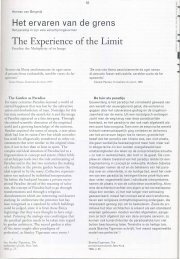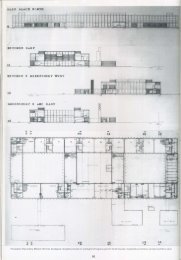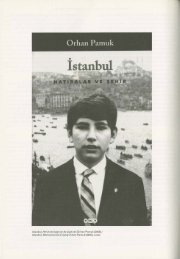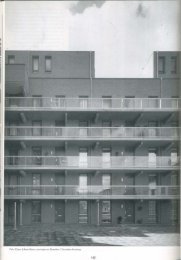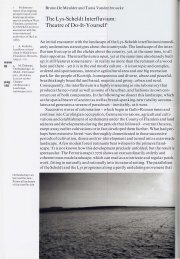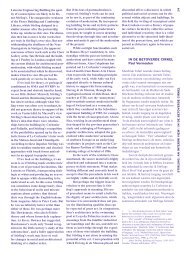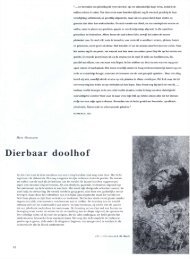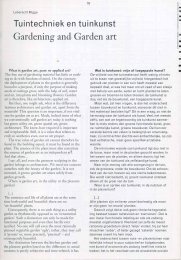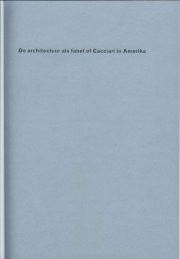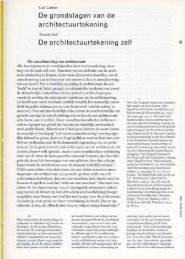Download PDF, 11 pagina's, 761 KB - OASE Journal for Architecture
Download PDF, 11 pagina's, 761 KB - OASE Journal for Architecture
Download PDF, 11 pagina's, 761 KB - OASE Journal for Architecture
Create successful ePaper yourself
Turn your PDF publications into a flip-book with our unique Google optimized e-Paper software.
<strong>OASE</strong> 67 After the party<br />
Een wereld van verschillen<br />
of een andere wereld?<br />
I renee Scalbert<br />
lk herinner me nog heel goed het moment, nu tien jaar geleden, dat ik werd ge<br />
attendeerd op het project Borneo-Sporenburg van bureau West 8. Dit plan leek<br />
a lies te hebben wat aan Britse stedenbouwkundige plannen ontbrak: fantasie<br />
en kunde, intelligentie en engagement. Het stond haaks op de destijds heer<br />
sende opvatting dat steden chaotisch zijn en zich dus aan elke menselijke con<br />
trole onttrekken. Borneo-Sporenburg leek nu juist een voorbeeld van een nieu<br />
we harmonie tussen degenen die voor deze stedelijke chaos verantwoordelijk<br />
zijn en de architecten die er orde in trachten te scheppen. Steden konden weer<br />
gepland worden, maar dan zonder het typo-morfologische keurslijf dat ze al zo<br />
lang ontgroeid waren.<br />
Sindsdien zijn tien jaar verstreken. Verbazingwekkend genoeg werd het<br />
plan Borneo-Sporenburg daadwerkelijk gerealiseerd, en er werd nog vee I<br />
meer gebouwd.Toch is het momenteel bon ton om tekeer te gaan tegen de<br />
Nederlandse architectuur, te klagen over de zielloosheid van de nieuweVinex<br />
wijken en te sneren over de moedwillige oppervlakkigheid van het Nederlandse<br />
ontwerp.Toegegeven, het stratenplan van Borneo-Sporenburg is even onver<br />
biddelijk rechtlijnig als de rijen opeengestapelde scheepscontainers die er<br />
de inspiratie voor vormden. De herverdeling van de ruimte van de straat naar<br />
de woning, die nu vaak een of meerdere patio's omsluit, heeft geleid tot smalle,<br />
boomloze straten die te laag zijn om zich ooit te kunnen met en met de minerale<br />
toverkracht en de pracht van, zeg, de Via Giulia in Rome. En de hoogbouw die in<br />
het plan is opgenomen om het een grot ere dichtheid te geven, accentueert niet<br />
zeals gehoopt de straten zeals II Redentore dat op Guidecca doet, of trouwens<br />
het Palazzo Farnese aan de Via Giulia.Toch is er met het project Borneo<br />
Sporenburg iets uitzonderlijks tot stand gebracht.ln welk ander masterplan<br />
werd op een dergelijke schaal zoveel kwaliteit bereikt in de details?<br />
In een recente lezing op de Architectural Association in Landen ging<br />
Adriaan Geuze van West 8 kort in op een ontwikkelingsproject van vergelijk<br />
bare schaal in Kopenhagen. Vervolgens verloor hij zich in buitenissige fanta<br />
sieen, zeals een voorstel om pal men te Iaten groeien boven de straatverlich<br />
ting in de midden berm van een snelweg in Cali<strong>for</strong>nie. Na een serieus begin<br />
kreeg lacherigheid de overhand. Ook in de Nederlandse beweging ontaardden<br />
het optimisme, dat bij Borneo-Sporenburg zo onwankelbaar leek, en de onstil<br />
bare honger naar actie, bij de jongere navolgers van Geuze en zijn leeftijdgeno<br />
ten al te gemakkelijk in zelfspot en zelfparodie. De moedwillige oppervlakkig<br />
heid die eerst een teken was van uitzonderlijke vitaliteit wijst nu op een gebrek<br />
aan inhoud. De onelegante eindsprint (want de Nederlandse architectuur<br />
beweging was niet aileen een partij, maar ook een race) is vergelijkbaar met<br />
de opwinding aan de start en speelt degenen in de kaart die dit moment in de<br />
Nederlandse architectuurtoch al afdeden als een kortstondige opleving en niet<br />
meer dan dat. Het is wei zo dat we aan deze tweede moderniteit (om met Bart<br />
Lootsma te spreken) geen iconen van bouwkunst, geen Schroder-huizen heb<br />
ben overgehouden. Zelfs hetVPRO-gebouw, dat nog het vaakst wordt genoemd<br />
als kandidaat voor deze status, bestond al in meer dan embryonale vorm in<br />
OMA's inzending voor de prijsvraag voor de Jussieu-bibliotheek. Bovendien<br />
heeft het qua invloed inmiddels concurrentie van I at ere variaties op hetzelfde
thema, zoals de Nederlandse ambassade van OMA in Berlijn.<br />
Het mag paradoxaal klinken, maar dit gebrek past heel goed bij een archi<br />
tectuur die haar expressie toch al niet zocht in unieke projecten of charisma<br />
tische individuen. Met hun doorzettingsvermogen en intelligentie waren Winy<br />
Maas, Kees Christiaanse, Adriaan Geuze en Wi II em Jan Neutel ings, om er<br />
maar vier te noemen, cruciale gang makers. Maar het werk dat van hun teken<br />
tafels kwam leverde hun geen exclusieve identiteit op, geen angstvallig be<br />
schermd handelsmerk.ldeeen verspreidden zich snel en werden publiek eigen<br />
dom zodra ze openbaar werden gemaakt. Copyright had geen enkele betekenis<br />
zolang de architecten maar om beurten koploper mochten zijn. De tweede<br />
moderniteit van de Nederlandse architectuur was een collectieve beweging.<br />
Het was geen beweging van auteurs maar van doeners en ze bracht geen<br />
oeuvres voort maar werken. De prikkels ervan kwamen eerder van onderaf<br />
dan van haar !eiders.<br />
Zulke momenten zijn zeldzaam in de architectuur. De Nederlandse<br />
beweging is te vergelijken met de architectuur en stedenbouw in het Spanje<br />
na Franco, met de door de verzorgingsstaat gefinancierde uitbreiding van<br />
Stockholm na de oorlog en met de omvangrijke woningbouwprogramma's ten<br />
tijde van deWeimarrepubliek in Frankfurt en Berlijn. Niet dat individuele prestaties<br />
moeten worden gebagatelliseerd ter meerdere glorie van het collectieve 1<br />
werk aan het poldermodel. Het bovenstaande maakt wei d'Uidelijk hoe diep de<br />
Nederlandse architectuur inmiddels in de samenleving was ingebed. In geen<br />
enkel ander tijdperk, ook niet in Spanje, Zweden of Duitsland, waren steden<br />
bouwkundige plannen ge<strong>for</strong>muleerd op de schaal van een heel land. Neem bij<br />
voorbeeld de 'nieuwe kaartvan Nederland', gepubliceerd in 1977 in het kader<br />
van de Derde Nota Ruimtelijke ordening, waarop aile projecten stonden die in<br />
2005 moesten zijn voltooid en, hiermee vergelijkbaar maar van een andere orde,<br />
de door MVRDV georganiseerde expositie 'Metacity/Datatown ', waarin werd<br />
gespeculeerd over de toekomst van het nationale grondgebied. Het geringe<br />
oppervlak van Nederland maakt een dergelijke visie natuurlijk gemakkelijker<br />
mogelijk, maar zeker niet vanzelfsprekend. In scherp contrast hiermee staat<br />
Belgie, nog kleiner dan Nederland en niet minder dichtbevolkt, waar van een<br />
dergelijk bewustzijn geen sprake lijkt.<br />
De Nederlandse beweging ontstond bij OMA, zo wordt beweerd. En<br />
inderdaad, Christiaanse, Neutelings en Maas hebben er alledrie gewerkt.<br />
Rem Koolhaas zou wei eens 'niet aileen het geweten van de Nederlandse<br />
architectuur kunnen zijn geweest, maar ook de katalysator van haar ontwikke<br />
ling', zoals Bart Lootsma in SuperDutch schreef. Misschien heeft Koolhaas<br />
zijn werknemers wei opgezadeld met een geniecomplex, zoals Bernard<br />
Colen brander het in Re{erentie OMA noemt. Zeker is dat vee I thema's die in<br />
Nederland een centrale rol gingen spelen, zoals dichtheid en kunstmatigheid,<br />
tot in detail door Koolhaas en zijn coli ega's in kaart zijn gebracht. Door OMA<br />
gehanteerde methoden, zoals de laagsgewijze opbouw van de programma's<br />
voor La Villette, werden bij Borneo-Sporenburg, Leidsche Rijn en elders ge<br />
meengoed. OM A's surrealistische vormenspel is nadrukkelijk aanwezig in<br />
MVRDV's Nederlandse paviljoen voor de Expo 2000 in Hannover, in het niet<br />
gerealiseerde antwerp van Neutelings en Riedijk voor een concertgebouw in<br />
Brugge (een met bloemmotieven versierde kolos), en op vee I andere plaatsen<br />
in de Nederlandse architectuur. Dat de voormalige werknemers van Koolhaas<br />
hun ervaring bij OMA met zich meedroegen, is onmiskenbaar en niet minder<br />
vanzelfsprekend dan bijvoorbeeld de blijvende invloed van de ltaliaanse<br />
Tendenza op de Spanjaarden of de invloed van Raymond Unwin op het werk<br />
van Ernst May in Frankfurt.<br />
Een wereld van verschillen of een andere wereld? I renee Seal bert<br />
Deze aanwijsbare verwantschap doet niets af aan de verschillen tussen
<strong>OASE</strong> 67 After the party<br />
OMA en de Nederlandse beweging. Jarenlang bleef OMA-architecten onver<br />
moeibaar op hun nietigheid wijzen. Steden als New York waren zulke gigan<br />
tische fenomenen dat de architectuur er wei bij in het niet moest vall en. Op die<br />
schaal worden een huizenblok in Manhattan en een decoratie op een wolken<br />
krabber in Singapore onder ling inwisselbaar en vall en verschillen tegen elkaar<br />
weg.ln de generieke stad van Koolhaas doen architectonische verschillen er<br />
niet meer toe. Junkspace is de logische apotheose van deze waardenivellering.<br />
Voor de Nederlandse beweging geldt precies het omgekeerde. Hier worden de<br />
architecten niet, zoals bij Koolhaas het geval is, aangetrokken door de macht<br />
van de hoge omes zoals het genie door het flakkerende Iicht van het mecenaat.<br />
Architectuur isniet I outer een schaamlap voor projectontwikkelaars. Het is<br />
een lang uitgerel
eentonigeVinex-projecten -verschil steeds belangrijker.<br />
De Nederlandse beweging onderkende dat we momenteel leven in een tijd<br />
perk van cijfers en getallen-het dome in van de stedenbouw.Tegelijkertijd zag<br />
ze een individualiserende samenleving waarin men sen in een toenemend ge<br />
differentieerde omgeving Ieven-het dome in van de architectuur. De grote be<br />
tekenis en verdienste ervan liggen in het blootleggen en gedeeltelijk oplossen<br />
van de kennelijke tegenstell ing tussen massa en individu, tussen kwantiteit en<br />
kwal iteit, tussen de noodzaak om te plannen en het verlangen naar plezier. Een<br />
voorbeeld daarvan is de installatie van 800.000 modelhuisjes door Geuze en zijn<br />
student en. In deze in 1995 gehouden expositie, bedoeld om het publiek attent<br />
te maken op de sluipende eenvormigheid van nieuwbouwwijken, werden zakken<br />
vol huisjes in suikerklontjes<strong>for</strong>maat leeggestort op pallets, en onder de arcade<br />
van het NAi geschoven: ziehier de barre feiten van de verstedelijking.<br />
Vervolgens werden ze in I ijn- en rasterpatronen gelegd, als een snoer of als een<br />
netwerk, net hoe de studenten het wilden (ziehier de willekeur van de architec<br />
tuur), in een uitstalling die een lust was voor het oog en een uitdaging voor de<br />
gee st. Met deze expositie werd dezelfde vraag gesteld, maar dan verplaatst<br />
naar hetterrein van de stedenbouw, die ook Michael Hardt en Antonio Negri<br />
aan de orde stellen in hun recente boekDemenigte: hoe kanje massa zich esthetisch<br />
en rationeel organiseren, zodanig dat een kwantitatieve oneindigheid 1<br />
samengaat met een oneindige verscheidenheid.<br />
Het nieuwe Utopia was er een van totaal verschil. Het werd ge"inspireerd<br />
en gelegitimeerd door een groot aantal projecten, met name door Kowloon<br />
Walled City en MVRDV's 'op zijn kant gezette Mietskaserne' (een op zijn kant<br />
gezet Kowloon?), ontworpen voor een locatie in Berlijn in 1991, niet lang nadat<br />
KWC internationaal in de publiciteit was gekomen. In dit Utopia bestond ver<br />
schil niet Ianger enkel in de private en geprivatiseerde fantasie, in de autonome<br />
door neutrale rasters verbonden blokken en de door neutrale liften verbonden<br />
autonome verdiepingen, die de visie van Koolhaas op New York hadden be<br />
paald. Verschil werd gesitueerd of, om een term te gebruiken die sindsdien<br />
gemeengoed is geworden, overeengekomen. Zo verloor het vee I van de wille<br />
keur die voor Koolhaas het ontwerpen tot zo'n 'ondraaglijke klus' had gemaakt.<br />
Het vond zijn legitimering in de continu"iteit van gebeurtenissen, bijvoorbeeld<br />
in de opeenvolging van ontmoetingen die de indeling van de appartementen in<br />
het Silodam-gebouw bepaalden, en de samenhang van de ruimten, bijvoor<br />
beeld in MVRDV's Chinese puzzel voor Berlijn. Verschil was niet Ianger wille<br />
keurig en bijkomstig: het was nu structureel. Programmatische onbepaaldheid<br />
maakte plaats voor een aan de stroom van gebeurtenissen toegeschreven<br />
determinisme. Architectonische specificiteit, namelijk het creeren van ver<br />
schil, waarvan de willekeurigheid zo ondraaglijk was geweest, werd spontaan,<br />
speels en leuk.<br />
Maar verschil liet geen ruimte voor een hog ere rede, en zo vie I dus ook de<br />
existentiele walging niet uit te bannen die Koolhaas tijdens het ontwerpen had<br />
bevangen. Het Utopia van totaal verschil was een perfect antwoord op de indi<br />
vidualisering. De stad van eindeloze verscheidenheid, in verschillende grada<br />
ties weerspiegeld in Borneo-Sporenburg, in de plannen van Christiaanse voor<br />
het GWL-terrein in Amsterdam en in het Silodam-gebouw van MVRDV, werd<br />
het favoriete terre in voor de 'jagers en verzamelaars' van open bare plekken,<br />
degenen die, in Reijndorps welgekozen woorden, 'het recht uitoefenen incon<br />
sequent te zijn' in de manier waarop ze hun Ieven leiden. Verscheidenheid in de<br />
fysieke wereld, de aantallen verschillen die deze telt, werd de geaccepteerde<br />
metafoor voor de kwaliteit van het Ieven.<br />
Een we reid van verschillen of een andere wereld? I renee Seal bert<br />
Bij gebrek aan een hoger principe kon aan de wen sen van de jagers en ver<br />
zamelaars aileen tegemoet worden gekomen via een drastische vermeerdering
<strong>OASE</strong> 67 After the party<br />
in het aantal specifieke plaatsen. Het aantal verschillen werd een kwaliteit op<br />
zich, ongeacht hun a a rd. Zolang de verscheidenheid leek toe te nemen, zolang<br />
de fictie van een we reid die aile denkbare plaatsen omvat (wat doet den ken aan<br />
Borges' bibliotheek van Babel, die aile mogelijke boeken bevatte) in stand kon<br />
worden gehouden, konden mensen erop vertrouwen dat ze de plaats zouden<br />
vinden waarnaar ze verlangden, zo niet vandaag, dan toch ooit.<br />
Maar het bieden van verscheidenheid gaf geen bevrediging. De wildernis<br />
blijft ongrijpbaar in deVinex-wijken. Verschillen Iaten de men sen in AI mere<br />
even koud als in Koolhaas' generieke stad. Is dat wei zo? Is al die ontwerpar<br />
beid werkelijk voor niets geweest? lk betwijfel het. Wat het antwoord ook is, de<br />
beperkingen VQn de Nederlandse beweging liggen ergens anders.ln de jaren<br />
negentig werd gevierd wat Fukayama het einde van de geschiedenis noemde.<br />
HetWesten had gewonnen in de Koude Oorlog en de ideologische strijd maak<br />
te plaats voor I outer economische activiteit. De architecten van hun kant voel<br />
den zich niet geroepen te reageren op de maatschappelijke vraag. Liever pro<br />
beerden ze als een soort marktonderzoekers te anticiperen op de commerciele<br />
vraag met nieuwe, steeds aantrekkelijker voorstellen. Architectuur werd een<br />
op zichzelf staand experiment, een gok.<br />
In deze omstandigheden verloor het concept van het type, het den ken in<br />
model len dat zowel modernisten als traditionalisten zo dierbaar is, zijn beteke<br />
nis. Het beschreef niets anders dan een herhaling van hetzelfde. Anderzijds<br />
werd het ontwerp van specifieke plaatsen, het creeren van verschil dat zo cen<br />
traal stond in het alternatieve modernisme van A alto en Scharoun, niet Ianger<br />
bepaald door de bijzonderheden van de locatie en het programma. Oat volgde<br />
voor een dee I de grillige fantasie van de architecten, zoals in The City of the<br />
Captive Globe van Koolhaas, en voor een dee I de niet minder grillige, althans<br />
onvoorspelbare ups en downs van de projectonderhandelingen.ln be ide geval<br />
len had ook verschil geen betekenis meer. Meer dan differentiatie werd er niet<br />
mee aangeduid.<br />
De tijden zijn veranderd. We zaten dus aan het einde van de geschiedenis,<br />
nu staan we aan het begin van een zoektocht naar wat Hardt en Negri het ge<br />
meenschappelijke noemen. Economische activiteit, de markt die in de jaren<br />
negentig zo aanlokkelijk leek, staat nu voor de NieuweWereldorde.Tegenover<br />
deze wereldorde vormen de opkomst van de massa als politieke klasse en<br />
het besef wat deze gemeenschappelijk heeft volgens Hardt en Negri de enige<br />
toekomst voor de democratie, 'de regering van iedereen over iedereen'. De<br />
duizendjarige politiek van onbeperkte consumptie wordt ondermijnd door het<br />
ontstaan van een hernieuwde ideologische strijd. De huidige ontwikkelingen<br />
in de Nederlandse architectuur, bijvoorbeeld het werk van AtelierVan Lieshout,<br />
wijst zo nu en dan al in die richting. Maar bovenal wijzen ze op een rappel a<br />
l'ordre, een terugvallen op oudere, schijnbaar universele waarden, op de heilig<br />
heid van de gebruiker en het gezonde verstand van een goede constructie.<br />
Nadat in de intellectuele gisting van de jaren negentig de maatschappelijke<br />
behoeften geheel ondergesneeuwd waren geraakt, werd nu weer historisch<br />
houvast gezocht, met name bijTeam 10 en de maatschappelijke experimenten<br />
van de jaren zeventig. Nostalgische omwegen zijn wei Iicht nodi g. Maar waar<br />
het om gaat is de relatie van de architectuur, niet met haar veri eden maar met<br />
haar heden, met de recente beroering in de samenleving.<br />
De Nederlandse beweging ging uit van het bestaan van de mas sa, waar<br />
voor haar werk in feite een theorie vormt. Zolang die massa een verzameling<br />
passieve consumenten bleef, konden de projecten in een los en willekeurig<br />
verband met de samenleving staan. Maar als de massa zich roert en zijn eisen<br />
<strong>for</strong>muleert, gaat het op gemakzucht lijken als de betrokkenheid van architecten<br />
met de maatschappelijke werkelijkheid zich beperkt tot de details van een af-
zonderlijke opdracht. Het invoelingsvermogen van de Nederlandse beweging<br />
was gernspireerd en juist. Laat nu jongere architecten uit de vergaderkamer<br />
stappen, attent blijven op de bewegingen vanuit de menigte en het publiek half<br />
weg tegemoetkomen. Dan zal het creeren van verschil de maatschappelijke<br />
relevantie en politieke doelgerichtheid krijgen die het ondanks aile zelfvoldane<br />
eigenzinnigheid duidelijk mist.<br />
Vertaling: Auke van den Berg, Bookmakers<br />
Een we reid van verschillen of een andere we reid? I renee Seal bert<br />
/'<br />
I
<strong>OASE</strong> 67 After the party<br />
A World of Differences<br />
or a Different World?<br />
I renee Scalbert<br />
I remember vividly the moment when, some ten years ago, West 8's project <strong>for</strong><br />
Borneo-Sporenburg was first brought to my attention. The plan appeared to<br />
have everything which British planning lacked: imagination and competence,<br />
intelligence aqd engagement. It flew in the face of the then fashionable opinion<br />
according to which cities are chaotic and lie there<strong>for</strong>e beyond any possibility of<br />
human control. Borneo-Sporenburg suggested instead a new concord between<br />
the agents responsible <strong>for</strong> this urban chaos and architects attempting to bring<br />
order to it. Once again cities could be planned, yet remain unencumbered by the<br />
typo-morphological garments which they had long outgrown.<br />
A decade has passed.The plan <strong>for</strong> Borneo-Sporenburg, amazingly, was<br />
realised, and much else was built besides. And yet it is now in good taste to<br />
vituperate against Dutch architecture, to lament against the soulless aspect<br />
of the newVinex suburbs, to sneer at the wilful superficiality of Dutch design.<br />
The streets of Borneo-Sporenburg are, it is true, no less relentless in their<br />
alignments than the stacks of ship containers which inspired them. The redis<br />
tribution of space from the street to the dwelling which now includes one or<br />
several patios resulted in narrow, tree-free corridors which are too low to ever<br />
share the mineral charm and splendour of, say, Via Gulia in Rome. And the large<br />
multi-storey buildings introduced in the plan to boost its density do not quite<br />
punctuate the streets, as hoped, in the manner of II Redentore on the Guidecca<br />
or, <strong>for</strong> that matter, the Palazzo Farnese on Via Gulia.Yet Borneo-Sporenburg<br />
represents an achievement of exceptional magnitude. Which other master plan<br />
delivered more quality in the details on such a scale?<br />
In a recent lecture at the Architectural Association in London, West 8's<br />
Adriaan Geuze skimmed over a development on a comparable scale <strong>for</strong><br />
Copenhagen. He then described at length over-the-top fantasies, including a<br />
proposal <strong>for</strong> growing palms over street lights in the central reservation of a<br />
Cali<strong>for</strong>nian highway. The earnestness of the beginning muted into mirth at the<br />
end. Likewise in the Dutch movement, the optimism which once had seemed so<br />
unshakable at Borneo-Sporenburg, the blazing appetite <strong>for</strong> action, too easily<br />
descends into self-deprecating parody among the younger architects following<br />
in the wake of Geuze and his contemporaries. The wilful superficiality which<br />
had been the sign of an exceptional vitality now points to a vanishing of sub<br />
stance. The inelegance of the finish (<strong>for</strong> t he Dutch movement, if it was a party,<br />
was also a race) is on a scale with the excitement at the start, and it plays in<br />
the hands of those <strong>for</strong> whom this moment in Dutch architecture was never<br />
less than a flash in the pan. Admittedly, this second modernity (to borrow<br />
Bart Lootsma's expression) left no seminal buildings, no Rietveld Schroder<br />
houses behind. Even theVPRO building which most frequently contends <strong>for</strong><br />
iconic status existed as more than an embryo in OM A's competition <strong>for</strong> the<br />
Jussieu library. And it must now compete <strong>for</strong> influence with later variations<br />
on the theme, <strong>for</strong> instance OMA's Dutch Embassy in Berlin.<br />
Paradoxical as it may seem, this lack is wholly appropriate to an architec<br />
ture which did not seek expression in singular projects or in charismatic indi<br />
viduals. The stamina and the intelligence ofWiny Maas, of Kees Christiaanse,<br />
of Adriaan Geuze and Wi II em Jan Neutel ings, to name but four, were vital pace-
makers. But the work produced in their offices generated no exclusive identity,<br />
no jealously protected trademark. Ideas travelled fast and became common<br />
property as soon as they were made public. Copyright was of no significance so<br />
long as architects could take turns in leading the race. The second modernity of<br />
Dutch architecture was a collective movement. It was animated by actors rath<br />
er than authors, and it produced works, not oeuvres. Its impulse was not given<br />
by leaders: it resided in the mass.<br />
Such moments are rare in architecture. The Dutch movement is on a par<br />
with architecture and planning in Spain after Franco, with the post-war expan<br />
sion of Stockholm sponsored by the Welfare State, and with the large housing<br />
programmes built in Frankfurt and Berlin during the Weimar Republic. This is<br />
not to dismiss individual achievements so as to better praise collective work<br />
on the Polder Model. Rather it is to draw attention to how deeply Dutch archi<br />
tecture was then imbedded in society. At no other time, not even in Spain,<br />
Sweden or Germany, had physical planning been envisaged at the scale of<br />
the whole country. Witness <strong>for</strong> instance the' New Map of the Netherlands'<br />
launched in 1997, showing all projects due <strong>for</strong> completion by 2005 and, in a<br />
different register, MVRDV's exhibition Metacity Datatown, speculating on the<br />
future of the country's territory. Admittedly the small size of the Netherlands<br />
made it possible, but it did not make it necessary. This is in sharp contrast with <br />
Belgium, a smaller and no less populated country, which offers no evidence of _<br />
a comparable consciousness.<br />
A World of Differences or a Different World? I renee Seal bert<br />
The Dutch movement, it is claimed, originated in OMA. Christiaanse,<br />
Neutelings and Maas all worked, it is true, at the Office. Rem Koolhaas may<br />
have been 'not only the conscience of Dutch architecture, but the catalyst of its<br />
development' , as Bart Lootsma wrote in SuperDutch. Koolhaas may have in<br />
duced among his employees the genius complex which Bernard Colen brander<br />
analyzed in Reference-OM A. For sure many themes that became central in the<br />
Netherlands, <strong>for</strong> instance density and artificiality, were charted in detail by<br />
Koolhaas and his colleagues. Methods practised at OMA, <strong>for</strong> instance the lam<br />
ination of programmes invented <strong>for</strong> Ia Viiiette, became ordinary fare at Borneo<br />
Sporenburg, Leidsche Rijn and elsewhere. OMA's Surrealist <strong>for</strong>mal play looms<br />
large in MVRDV's Dutch pavilion at Hanover 2000, in Neutelings Riedijk's<br />
unbuilt decorated hulk of a concert hall <strong>for</strong> Bruges as in so much else in Dutch<br />
architecture. That Koolhaas's one-time employees carried within themselves<br />
their experience at OMA goes without saying, and it is no less in the order of<br />
things than, say, the lasting impact of the ltalianTendenza upon Spaniards,<br />
or the influence of Raymond Unwin upon Ernst May's work at Frankfurt.<br />
Yet this paternity should not hide differences between OMA and the Dutch<br />
movement. For many years OMA had beaten the drum to awaken architects to<br />
their insignificance. Cities like New York were events of such magnitude that<br />
they could only dwarf architecture. A block in Manhattan, a skyscraper finial in<br />
Singapore are worth any other in such a way that differences cancel each other<br />
out. In Koolhaas's generic city, architectural differences no longer matter.<br />
Junkspace is the logical apotheosis of this haemorrhage of value. In the Dutch<br />
movement, exactly the opposite is true. Architects are not drawn, like Koolhaas,<br />
to bigwigs power like genius to the flickering light of patronage. <strong>Architecture</strong><br />
is no mere alibi <strong>for</strong> developers. It is instead a long-drawn negotiation between<br />
the purse-holders and a hypothetical new collectivity. Koolhaas speaks to<br />
lifestyle guru Martha Stewart, but MVRDV collaborate with sociologist Arnold<br />
Reijndorp. For the Dutch movement, difference matters. Indeed, in a society<br />
where individualisation is going apace, difference is all.<br />
There is more. For Koolhaas, architecture must heed the processes of<br />
urbanism if it is to survive (assuming that it deserves to do so). For the Dutch
<strong>OASE</strong> 67 After the party<br />
movement, urbanism and architecture may sometimes be in conflict, as the<br />
lament about the failure ofVinex suggests. But they are not locked in an ines<br />
capable contradiction. To the contrary, the Dutch movement showed that in an<br />
increasingly privati sed economy one could have, as in Borneo-Sporenburg,<br />
urbanism and architecture. When Koolhaas revelled in the capricious politics<br />
of genius (admittedly relevant in the market of exception in which he chose to<br />
operate), the Dutch movement showed political maturity and realism.<br />
Clearly there is more to the Dutch movement than Koolhaas. And there is<br />
more to it, too, than the much taunted Americanisation of the Netherlands. In<br />
a country where social housing was the queen bee of commissions and where,<br />
moreover, legislation on its provision had remained unchanged throughout the<br />
twentieth century, the remov,al in 1994 of subsidies <strong>for</strong> housing associations<br />
opened the floodgates to the new architecture. Deregulation invited a new,<br />
exhilarating disorder. Peripheries acquired positive qualities. What had been<br />
<strong>for</strong> Koolhaas mere plankton became <strong>for</strong> Neutelings the engaging patchwork of<br />
his carpet metropolis. Geuze imagined a New Wilderness. Carel Weeber called<br />
<strong>for</strong> Wild Housing and the abolition of planning controls <strong>for</strong> private dwellings.<br />
And MVRDV envisaged a Light Urbanism in which the abolition of public ser<br />
vices would bring about an ecology of ginger homes speckled in a restored,<br />
expansive nature. At one end of the spectrum, suburbs were to evaporate into<br />
aVirgilian dream. At the other, they were to condense into Kowloon-like devel<br />
opments, into the Concentration City which J.G. Ballard brilliantly conjured in<br />
the 1957 short story of that name.<br />
Was this American?The US showed little or no interest in this new wilder<br />
ness. Ultimately, nothing could reconcile the expectations vested in privatisa<br />
tion in the US and Holland. If on both sides of the Atlantic the justification <strong>for</strong><br />
capitalism remains the procurement of pleasure, it entails in America the provi<br />
sion, whether byWalmart or by house builders, of more and more of more or less<br />
the same. In Holland to the contrary (the relative monotony ofVinex develop<br />
ments not withstanding) difference increasingly matters.<br />
The Dutch movement recognised that, today, we live in the age of numbers<br />
-this is the province of urbanism. At the same time, it observed a society be<br />
coming progressively more individualised and living in an environment which is<br />
increasingly differentiated -this is the domain of architecture. Its signal merit<br />
is to have exposed and in part resolved the apparent contradiction between the<br />
mass and the individual, between quantity and quality, between the necessity<br />
of planning and the desire <strong>for</strong> pleasure. This it did <strong>for</strong> instance in the installa<br />
tion of 800.000 model houses by Geuze and his students. In this exhibition<br />
staged in 1995to alert the public to a creeping suburban sameness, bags of<br />
sugar-size houses were unloaded on palettes, discharged and shovelled be<br />
neath the arcade of the NAi-such are the brutal facts of urbanism. They were<br />
then arranged into patterns of lines and nets, of laces and webs at the discre<br />
tion of students- such is the arbitrariness of architecture-in a display that was<br />
exhilarating to the eye and trying to the mind. The question raised by the exhibi<br />
tion was the same, transposed in the field of planning, as that which Michael<br />
Hardt and Antonio Negri address in their recent book Multitude: how could<br />
the mass organise itself aesthetically and rationally, in such a way that infinity<br />
in numbers combines with infinity in difference.<br />
The new Utopia was one of total difference. It was inspired and legitimated<br />
by a host of projects, by notably Kowloon Walled City, and MVRDV's 'flipped<br />
Mietkaserne' (a flipped Kowloon?) designed <strong>for</strong> a site in Berlin in 1991 not long<br />
after the KWC came to international attention. In this Utopia, difference no<br />
longer merely consisted in private and privati sed fantasy, in the autonomous<br />
blocks served by neutral grids and the autonomous floors served by neutral
lifts which had defined Koolhaas's vision of NewYork. Difference became situ<br />
ated or, to use a term that has since become widely used, negotiated. Hence<br />
it lost much of the arbitrariness which had made design an 'unbearable task'<br />
<strong>for</strong> Koolhaas. It found legitimacy in the continuity of events, <strong>for</strong> instance in the<br />
succession of meetings which determined the composition of apartments in<br />
the Sillodam building, and in the contiguity of spaces, <strong>for</strong> instance in MVRDV's<br />
Chinese puzzle <strong>for</strong> Berlin. Difference was no longer random and incidental:<br />
it was now structural. Programmatic indeterminacy gave way to a determinism<br />
attributed to the flow of events. Architectural specificity, namely the creation<br />
of difference, whose arbitrariness had been so unbearable, became instanta<br />
neous, playful and fun.<br />
Yet difference could not admit a higher reason and could not, there<strong>for</strong>e,<br />
fully exorcise the existential nausea which visited Koolhaas at the time of de<br />
sign. The Utopia of total difference was a perfect answer to individualisation.<br />
The city of endless variety which is reflected in varying degree at Borneo<br />
Sporenburg, in the GWL site in Amsterdam planned by Christiaanse, in the<br />
Silodam building designed by MVRDV, became the site of predilection <strong>for</strong><br />
'hunters and gatherers of public places', <strong>for</strong> those who exercise, in Reijndorp's<br />
felicitous phrase, 'the right to be inconsistent' in the conduct of their lives.<br />
Variety in the physical world, the quantity of its differences, became the<br />
accepted metaphor <strong>for</strong> the quality of I if e.<br />
In the absence of a higher principle, the best hope to meet the desires of<br />
hunters and gatherers was in a radical increase in the choice of specific places.<br />
The quantity of differences became a value in itself, irrespective of their nature.<br />
As long as variety was seen to be on the increase, as long as the fiction of a<br />
world including all conceivable places (reminiscent of Borges's Library of<br />
Babel which included all possible books) could be sustained, people could<br />
remain confident that they will find the place, if not today, then one day, which<br />
they had been longing <strong>for</strong>.<br />
A World of Differences or a Different World? I renee Seal bert<br />
But the provision of variety did not give satisfaction. Wilderness continues<br />
to elude the Vinex suburbs. Differences leave one no less indifferent in AI mere<br />
than they do in Koolhaas's generic city. But do they? Could so much design<br />
really have been in vain? I doubt so. Whatever the answer, the limitations of the<br />
Dutch movement lie elsewhere. The 1990s celebrated what Francis Fukayama<br />
called the End of History. The West had triumphed in the cold war and ideologi<br />
cal struggle gave way to pure economic activity. For their part, architects felt<br />
no compulsion to respond to social demand. Rather they sought, like market<br />
researchers, to anticipate commercial demand with new, ever more appealing<br />
proposals. <strong>Architecture</strong> became a sui-generis experiment, a gamble.<br />
In these conditions, the concept of type, the definition of models dear to<br />
modernists and historicists alike, became meaningless. It described nothing<br />
beyond the repetition of the same. Conversely, the design of specific places,<br />
the creation of difference which was dear to the alternative modernism of<br />
Aalto and Scharoun were no longer determined by the particulars of site and<br />
programme. They followed in part the arbitrary fantasy of architects, as exem<br />
plified by Koolhaas's City of the Captive Globe, and in part the no less arbitrary,<br />
or at least unpredictable, ups and downs of project negotiations. Either way,<br />
difference, too, was meaningless. It indicated nothing beyond differentiation.<br />
Times have changed. We were then at the End of History. We are today at<br />
the beginning of a search <strong>for</strong> what Hardt and Negri call the common. Economic<br />
activity, the market which had seemed so alluring in the 1990s now signify<br />
Empire. Confronted with such Empire, the emergence of the multitude as a<br />
political class, the realisation of what it has in common, represent, Hardt and<br />
Negri argue, the only future <strong>for</strong> democracy, <strong>for</strong> 'the rule of everyone by every-<br />
..#il"<br />
-
<strong>OASE</strong> 67 After the party<br />
one'.The millenarian politics of unlimited consumption are being undermined<br />
by a refreshed conception of ideological struggle. Current developments in<br />
Dutch architecture, <strong>for</strong> instance the work of AtelierVan Lieshout, occasionally<br />
point in this direction. But overall, they suggest a rappel-a-l'ordre, a falling back<br />
upon older, seemingly universal values, upon the sanctity of the user and the<br />
sanity of good construction. The intellectual ferment of the 1990s which had<br />
ballooned high above social wants is now tightening its historical moorings,<br />
with notably Team 10 and the social experiments carried out in the 1970s.<br />
Nostalgic detours may be necessary. At issue, however, is the relationship<br />
of architecture not to its past but to its present, to young stirrings in society.<br />
The Dutch movement presupposed the existence of the multitude <strong>for</strong> which<br />
its work constitutes in effect a theory. The arbitrariness in the connection of<br />
projects to society was sustainable so long as the multitude remained an<br />
aggregate of passive consumers. But were the multitude to stir and articulate<br />
its demands, the disengagement of architects from social reality beyond the<br />
particulars of each and every commission will come to seem indulgent. The<br />
broad intuition of the Dutch movement was inspired and right. Let now younger<br />
architects step out of the meeting room, remain attentive to the movement in<br />
the crowd and meet the public half-way. Then the creation of difference will<br />
gain the social meaning and the political purpose which, beneath airs of satis<br />
fied wilfulness, it plainly lacks.




